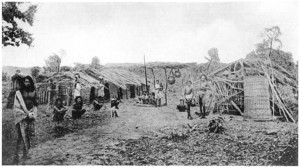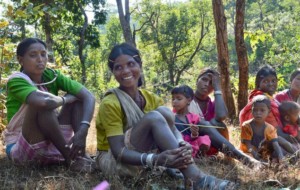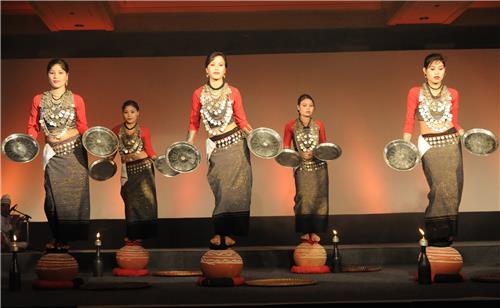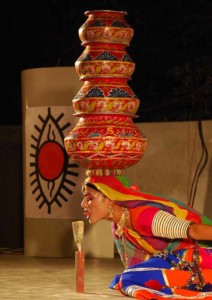One of the primary tribes of India, the Baigas, are semi-nomadic Dravidians living in the states of Madhya Pradesh, Uttar Pradesh, Chattisgarh and Jharkhand. A major part of them live in Baiga chuk, in the districts of Madla and Balaghal, in Madhya Pradesh. This tribe is divided into castes known as Bijhwar, Narotia, Bharotiya, Nahar, Rai Bhaina and Kadh Bhaina.
RESIDENCE OF THE BAIGAS
The Baigas, since they are semi-nomadic backward tribe, still live in kaccha houses made of clay with thatched roofs. Their houses are typically rectangular in shape, with only one entrance and possibly a small verandah. There are two rooms in the house divided by a single wall of bamboo. The outer room contains water stands and a hearth where fire is kept burning for warmth. The inner room consists of the place where the food is cooked and the devsthan, or the place where the Gods are kept and worshiped. People, other than the family members are not allowed to enter the inner room. The verandah consists of the kitchen accessories such as the grindstone, pestle and rice husker. The pig houses, and cattle sheds are attached to each house and have the same kind of structure as the houses of the Biagas.
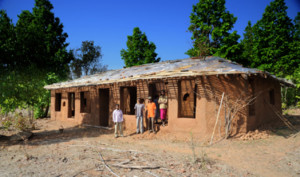 Such small houses form the Baiga villages which might be square in shape or might have the houses on either sides of a 10 meters broad street. Their villages are preferably located at isolated places where access of the outside world will be very difficult. While constructing the villages they also consider the aesthetic value and the agricultural capacity of the location. The village boundary is marked by piles of stones places around the village. According to the myth the village is guarded by a magic wall which prevents any wild animal from entering the village and also protects the villagers from diseases. They, however, do not enclose the fourth boundary of their village. This boundary is protected by a plantation of bamboos or cactus. The burial ground is located within the boundary of the village. The land for cultivation of plants like tobacco, maize and sweet potatoes are located outside the village, surrounding it rather.
Such small houses form the Baiga villages which might be square in shape or might have the houses on either sides of a 10 meters broad street. Their villages are preferably located at isolated places where access of the outside world will be very difficult. While constructing the villages they also consider the aesthetic value and the agricultural capacity of the location. The village boundary is marked by piles of stones places around the village. According to the myth the village is guarded by a magic wall which prevents any wild animal from entering the village and also protects the villagers from diseases. They, however, do not enclose the fourth boundary of their village. This boundary is protected by a plantation of bamboos or cactus. The burial ground is located within the boundary of the village. The land for cultivation of plants like tobacco, maize and sweet potatoes are located outside the village, surrounding it rather.
There are no granaries or temples in the village. Outside the village is a raised platform kind of structure, which is used by travelers and officials. These are known as Chattis and are owned by a single family and their relatives.
CULTURAL PRACTICE
 What we have heard about the Baigas is quite astonishing and might even be kind of limiting for their survival. Their interaction level is very low. In fact what might surprise you more can be the fact that communicating with the people of other tribes is considered a crime in their community. Now that’s some news as tribals mostly depend on each other for survival.
What we have heard about the Baigas is quite astonishing and might even be kind of limiting for their survival. Their interaction level is very low. In fact what might surprise you more can be the fact that communicating with the people of other tribes is considered a crime in their community. Now that’s some news as tribals mostly depend on each other for survival.
Another outcome of their backward thinking is that nobody, and by this I mean absolutely nobody, in this tribe is liable to receiving education. Although, many other tribes are educating their members but the Baigas have remained strictly attached to their old ways of dealing with the world. Another thing that they have prohibited among themselves is eating at places other than their own community.
A very old tradition followed by the Baigas is that when someone dies in their family they change their house. They probably prefer to leave behind the old memories and start life afresh.
All the Baiga men grow their own food since it is thought to be offending for a Baiga man to take up the job of a menial servant.
FOOD AND AGRICULTURE
Since they are mainly backward, and labour work is considered below their prestige level, they cultivate their own food. They use the method of shifting cultivation to grow their food comprising mainly of coarse food substances. They eat coarse grain and small quantities of flour. A main drink among them is pej, made from the water left after boiling rice or by grounding corn. They even consume leaves, rhizomes and mushrooms. Fruits also form a part of their diet. Their non vegetarian platter consists of small fishes and animals hunted by them.
Regarding their agricultural methods, you will find bounties of respect for Mother Earth, though it may raise the concern of environmentalists. They practice shifting cultivation instead of growing crops at the same piece of land again and again. The reason behind this is that they believe that growing crops at the same place would seem like offending Mother Earth and asking her to give more and more turning her sterile. Hence, after growing crops at one place they move from there. However, to grow the crops again they imply deforestation so that there is space for them to cultivate their crops.
They call their agricultural method “Bewar” or “Dhaiya”. Their respect might seem adorable to you for once but it has lead to serious environmental issues. There has been work going on, trying to prevent them from this kind of agricultural practice.
DRESS CODE
Baigas is a poor tribe due to which not much cloth is available for them. Men are seen wearing truss while carrying a piece of cloth used as a turban. The women wear a cloth known as dhoti. Children have been seen to go about naked usually. Noticeably, both the men and women wear clothes till knee level or above it.
However, on special occasions they are seen sporting different types of garments. Men dawn Haptos (shirts), Patkas (langots) and jackets. Women put on sarees. A few ornaments are also seen on the women.
RELIGION AND BELIEF’S
The Baigas, being one of the most backward tribe have believes and customs which showcases their profile. They do not marry someone from the same gotr. They also won’t marry someone whose family worships the same number of Gods as theirs.
However, one remarkable thinking in their society is the rule against child marriage. Another one is the widow re-marriage. There are different types of marriages in the Baiga society.
The Baigas have many Gods and Goddesses, but they are mainly nature worshippers like other tribes. Their main God is “Burha Deo”, along with other Gods and Goddesses such as Thakurdev, Khermai, Boodhi mai, Dulha dev and Narayan dev.
They are also believers of magic, both black and white. According to them, their ancestor, Nanga Baiga, was a great magician whose right shoulder was the source of white magic, whereas the left shoulder’s blood would lead to black magic. The Nanga Baiga’s son had drank from his right shoulder which paved his path to becoming a great magician of his times. The “andha Gond” and “langdi dhobin” had received blood from his left shoulder and became leading black magicians. The Baigas have different classes of magicians even now, ranging from those who are very powerful to those who can treat only minor diseases.
LIFESTYLE OF THE BAIGAS
Old Indian literature mentions of the naked people of Central India who used to burn forests and had a nomadic lifestyle. These people used to hunt for food and were completely uncivilised.
According to them they were the ones whom God had chosen to rule over the world. Formed by the conjugation of the Nanga Baiga (naked man) and the Nangi Baiga (naked woman), they bothered less about other people and chose to live their life in a manner they felt suited them. Later, however, with the development of the Gond civilisation, they shifted to the lands of the Gonds. There they found themselves jobs as priests and magicians.
With the introduction of British Raj in India, the Baigas had to be restricted. The British thought that the Bewar type of cultivation practised by the Baigas was ruining the land. As a result it was decided that they would be shifted to a region called Baiga Chuk. Some Baigas left the Bewar cultivation and settled down as farmers, however, some stayed put on their old ways of life with the Bewar type of agricultural practice. These were the people who had to settle down in the Chuk belt.
Now they live at Baiga Chuk, practicing their age old traditions.
Speaking of their age old tradition the Baigas follow the traditional way of getting ink on their body. Most of the body parts of the Baiga women are tattooed by “godharnis” from other tribes. Their tattoos have different designs, which distinguish them from the other tribes.
Another Baiga tradition that differentiates them from the other tribes is their dance forms. These different types of dances expresses the different types of emotions of the Baigas. There are songs and dances ranging from different events like mourning or even the first expression of love.
The Baigas are art loving though they are not very social. Their world is still captured in the mystic fables of magic and the power to rule the world. The earnest respect for Gods and Goddesses is very evident in the kind of life they lead. A poor scheduled tribe of India, which has survived the various marks of the changes during the different eras, the Baigas, still remains; a tribe proud of it’s culture, proud of it’s history. The Baigas- a name already placed in the rich ancient times of Indian Cultural History.

